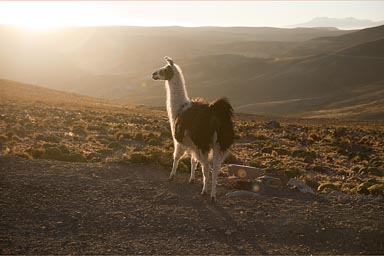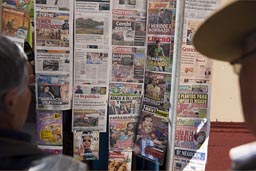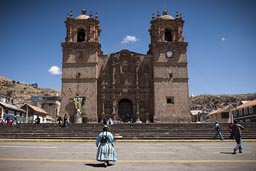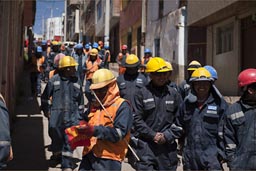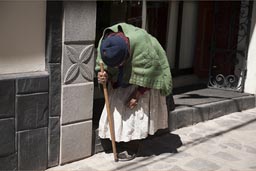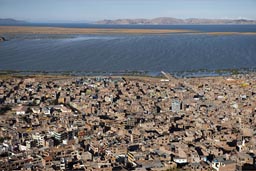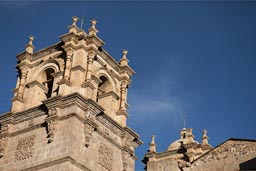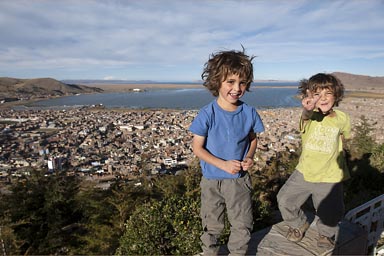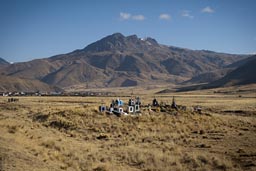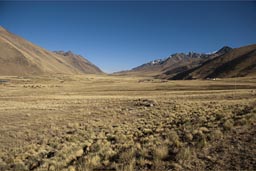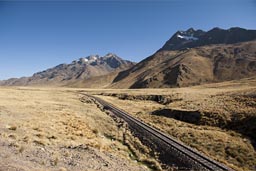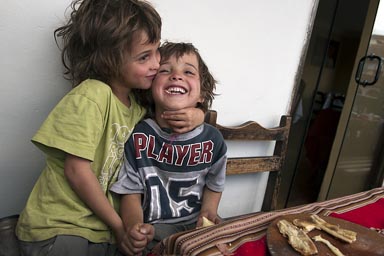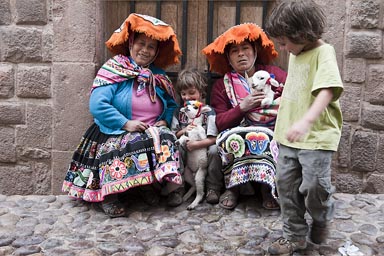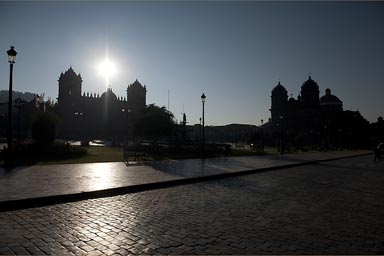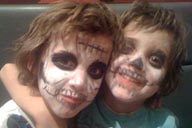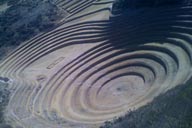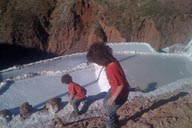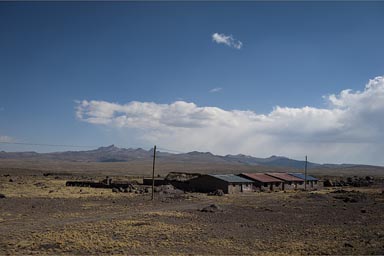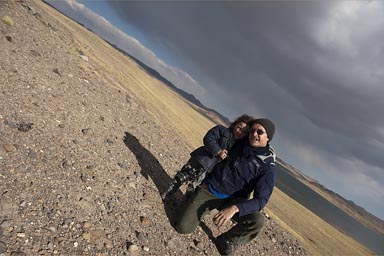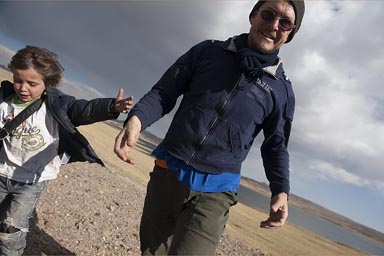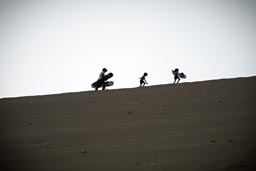www.thisfabtrek.com > journey > south-america > peru > 20120901-cuzco
Defying altitude sickness on the Altiplano.
Download GPS (KML) track/waypoints.
Finally we go north.
In complete defiance of our altitude sickness experience in Chile 2 days ago, we camp on 4,500m on the Altiplano, the high plains; it is indeed a massive plateau, once up, there is no more coming down, all is full of llamas and alpacas. We drive the longest time higher than 4,000m, forever, and sun sets and it sinks in that we would spend night here. This night no sickness occurs, it is just bitter cold, -10°C or lower, I pull the boys closer left and right, they sleep soundly, I don't, my knees hurt from the cold and I am worried, I can almost hear the water freezing and bursting my radiator and hoses. In the morning a thick layer of ice covers the windows inside, all pee and water bottles have turned to blocks of ice, and the radiator - certainly too and I wait till mid day when sun shines warm, well it is about time to get antifreeze coolant. The good thing is we are acclimatized to higher elevations now.
Puno then is a bit lower, is el capital folklórica del Perú, and I love that Andino music. But we come and there is a big strike on the plaza de armas, here not against the mine, but for better wages, and it triggers a chaos in traffic in Puno's narrow streets. Puno is on 3,800m, on Lake Titicaca which reaches way into Bolivia. As always in cities we take a hotel, at lunch I try the soup, rice and chicken tour for the boys and get pizza at night as a reward. The city of Puno extends from the lake uphill into the surrounding mountains, one afternoon we head out, up hundreds of steps to Condor Hill (4,015m), and the climb to my great surprising then doesn't bother us too much, certainly not my toughest Daniel and David, the view is stunning.
Thursday 23rd in Puno, we return to the van, the battery is flat, I demount it, we go on taxi to have it charged, then search for two new front tires. The butchers of mechanics in Lima where I had the steering rods changed, didn't align the wheels properly after, I had the alignment fixed in Tacna but that came to late for the tires, the iron ply was sticking out of the rubber already. All is expensive...
Late in the afternoon, I buy cheap Bolivian smuggled gasoline which is really just a little bit cheaper then regular at the pump. Then we go over the Altiplano north direction Cuzco.
Cuzco/Cusco/Qosqo, Coricancha/Qorikancha, Sacsayhuamán/Saksaq Waman/Sexy Woman.
The one thing that amazes on the fab trek is that so often the best thing is left for last: in this Peru case it is Inca and Colonial Cusco and what Inca treasures maybe around here, Machu Picchu is near! So I think, once we have gotten here and sit mid day in a balcony restaurant on plaza de armas, Cathedral and Compañía de Jesus just in front. I have Cusqueña, wait for Toño, the boys have pizza in the meantime, sun shines. Toño comes and it has been already a month since we met in Lima, he leads to the small restaurants in Pampa del Castillo; Adobo is the dish he chooses for me, cooked pork in a spicy paprika soup, a delight; one of the many distinct specialties of Peru's home cuisine.
Cusco is so important because many, if not all, early Colonial buildings, churches, palaces and plazas are built directly on the Inca foundations, sometimes, up to the first floor, the walls consist entirely of huge, round Inca cut and grated boulders, and some are better described as monoliths. This is maybe most pronounced in the Convent of Santo Domingo which was the old Coricancha/Qorikancha, Temple of the Sun whose walls were once covered with 'sheets of solid gold'; entire Inca rooms were completely incorporated in the church's and convent's structures.
Sunday, while down below on Cusco's plaza de armas the bands march and the soldiers parade, we climb to Sacsayhuamán/Saksaq Waman a walled city and fortress overlooking Cusco, with hundreds of meters of walls, in three layered terraces of huge monolithic stones, adjacent to a ceremonial plaza that held thousands of people. The boulders are again cut the Inca way, round, so they fit exactly into one another, without mortar; and the walls withstood the many earthquakes over the centuries without damage. Just the question remains of how the Inca transported the up to 200 tonnes heavy rocks from afar over mountains and ravines? The comparison with flat desert Egypt doesn't work.
How to get your camera stolen and but it back.
Carried by amazement, we descend onto a pub, and the boys after a while become a bit active and noisy, climb over the bar, and I go and sit next to them to calm them down and forget about my camera still sitting in the back, and it doesn't take the two thieves three minutes to carry it off. We have them on CCTV video, and the guys working for security identify one of them and involve the police. But then it drags on for the whole week, and I begin to internalize the fact that this D700 and beautiful 24-70 lens are gone and think about changing profession; I certainly look at the positive side of this voyage, that nothing has happened to the boys after all we have been through and that a camera is only money and the Gods have something else in mind for me...
The time in Cusco becomes a reality check of sorts and on Thursday we return to the van to find the battery is flat as usual, carry it to be charged as usual and then after 2 hours leave, to use our time, benefit and explore a bit, to Písac/Pisaq first, in what is called the Sacred Valley on the Urubamba River. In Inca Písac, a citadel on top, overlooking the valley and the surrounding Inca agricultural terraces, is where I find that there is something that I really like; photography, and I use my iphone 3, with crappy camera that manages nothing but blurry pictures.
Next morning we are off to Moray, another Inca archaeological site and the design of the incredible, perfect terraces leads many to believe that they were of experimental nature, a quasi agricultural industry project, to test what grows best where, as the micro climates and temperatures change as one descends into the hollow. Also we see the Maras Salinas in late sun, and I miss my photo camera again.
Evening I drown my frustrations in beer in Ollantaytambo and this is ante portas Machu Picchu, and there are impressive Inca ruins just around too, up mountain, and even as dusk falls I can make them out from our windy restaurant. As a photographer am I really damned to visit Machu Picchu without a heavy camera on a strap over my shoulder? I have gotten so used to it, I realize how much this has become my life.
Next morning I receive a phone call, the police has dug up an informant, who can produce the camera, but it costs 800USD (because he would have to buy it from a buyer, whatever), this is expensive and this is cheap, we return to Cusco immediately, Machu Picchu has to wait.
So I meet the police and then we wait all afternoon for the mysterious man to call, later I go with the police and we drive in their battered civil car, curve, park, wait, wait for another call. Finally the criminal comes and sits in the back, takes my estranged camera out of a plastic bag, I check it and it is mine indeed, check its functionality, the settings are all tossed about, after a nod the police hands him the money and the fixer disappears.
Quick and dirty.
But I have a camera back, my camera back, I could not have done that any cheaper.
Here you can read the How to get your camera stolen and buy it back? story.
Next morning I take the second picture, when sun goes up over plaza de armas and we leave Cusco. I have to come back, this much is clear.
It is the 2nd of September, I take the only second picture, when sun goes up over plaza de armas and we leave Cusco. Cusco to Lima is 1,100kms. After 13 hours almost constant driving mostly above 4,000m we reach Nasca. Dead tired we grab some sandwiches, and I don't like this Nasca, always loud, not safe, I don't want to leave the van for a minute. Dead tired, I have no choice but put my/our heads down, an hour later the Gods wake me, there is some scratching at the door, a guy's trying to break in. I get up, put my pants on, open the door and scream at the asshole. He just walks away.
I climb in the front, start the engine and drive us for 2 more hours to Huacachina, In the morning the boys are delighted when they realize where they are back, jump in the pool, and climb the high dunes with the sand boards, all day and I just watch from far.
I too want to chill, need the break, need to pack, there's no point to rush.
On 4th of September we go back to Paracas for a ceviche, then back to Lima late, back to drizzle and traffic.
On 5th, I disconnect the battery of the van, and we board a bus to Mancora where we get on the 6th, 1,100kms north from Lima, and it feels good to put the feet again into warm sand, and have a final Peruvian ceviche, after all... cold, sick, robbed, car problems, but amazingly happy. 2 days later we leave Peru after 102 days.
So how does this all play out? Turn page (yet to come).
www.thisfabtrek.com > journey > south-america > peru > 20120901-cuzco

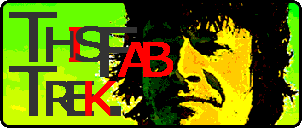
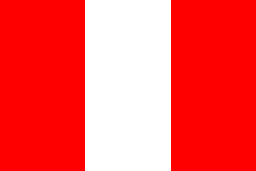
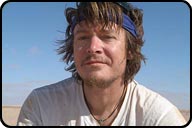
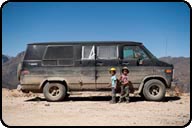


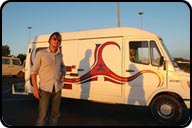
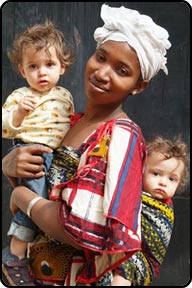
 contains Festival/Fiesta/Art photography.
contains Festival/Fiesta/Art photography.
